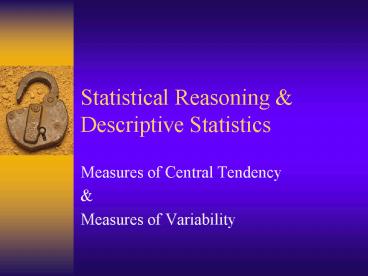Statistical Reasoning - PowerPoint PPT Presentation
1 / 14
Title:
Statistical Reasoning
Description:
Statistical Reasoning Describing Data. Statistical analysis helps us see what the naked eye misses. ... Tendency do not give us a complete picture of the data. ... – PowerPoint PPT presentation
Number of Views:20
Avg rating:3.0/5.0
Title: Statistical Reasoning
1
Statistical Reasoning Descriptive Statistics
- Measures of Central Tendency
- Measures of Variability
2
Statistical ReasoningDescribing Data
- Statistical analysis helps us see what the naked
eye misses. - Simplest type of graphical analysis is a BAR
GRAPH - Problems can be manipulated to show what the
researcher wants it to show.
3
Frequency Distribution
- Shows the frequency of given response/behavior
within the sample. - Plotted on a frequency histogram it gives a
pictorial representation of the data. - While helpful, it doesnt tell the whole story
4
Measures of Central Tendency
- Summarizes the data into an easily readable form.
Three types - MODE Most frequently occurring score
- MEAN Arithmetic average of all the scores.
- MEDIAN The score in the exact middle exactly ½
of the scores are above and ½ below.
5
Mean v. Median
- Median is often more accurate than the mean
because of extremes than can skew the scores up
or down.
6
If you performed below the mean, which group
would you want to be in? If you performed above
the mean, which group would you want to be in?
Median v. MeanEffect of Outliers
- Group 1
- 55
- 58
- 60
- 62
- 63
- 70
- 70
- 70
- 77
- 78
- 80
- 82
- 85
- Mean 70
- Group 2
- 55
- 64
- 68
- 69
- 69
- 70
- 70
- 70
- 71
- 71
- 72
- 76
- 85
- 70
- Mean 70
7
Median v. Mean Effect of Outliers
Mean 46,636
Median 40,000
Mode 30,000
8
Normal Curve
99.72
95.46
.14
.14
68.26
34.1
13.6
2.2
The normal or Bell curve is a statistical model
of how scores within a random sample should occur.
9
Normal Curve
- If scores in a set tend toward very high or very
low, it will create a skewed curve. - Skewed to the rightcalled a positive skew (there
are fewer frequencies at the higher end of the
scale). - Skewed to the left called a negative skew (fewer
frequencies at the lower end of the scale).
10
Measures of Central Tendency do not give us a
complete picture of the data.
11
Measures of Variability
- Variabilitythe way scores are distributed around
the center (median/mean). - The easiest way to check variability is by using
the range. - Range Highest score lowest score.
12
Range
What is the range of each set of scores? Is this
helpful? Why or why not?
Group 1 55 58 60 62 63 70 70 70 77 78 80 82 85 M
ean 70
Group 2 55 64 68 69 69 70 70 70 71 71 72 76 85 70
Mean 70
13
Problems with Range
- The range represents only the extremes
- To get more accurate data we have to have use a
statistic that takes in to account ALL of the
scores positions within the range.
14
Computing Standard Deviation
- Determine the mean of all the measurements in the
distribution - Subtract the mean from each measurement and
square the difference - Add the squares together
- Divide the sum of the squares by the number of
measurements - Take the square root of the value you obtained in
step 4. This is the standard deviation.

